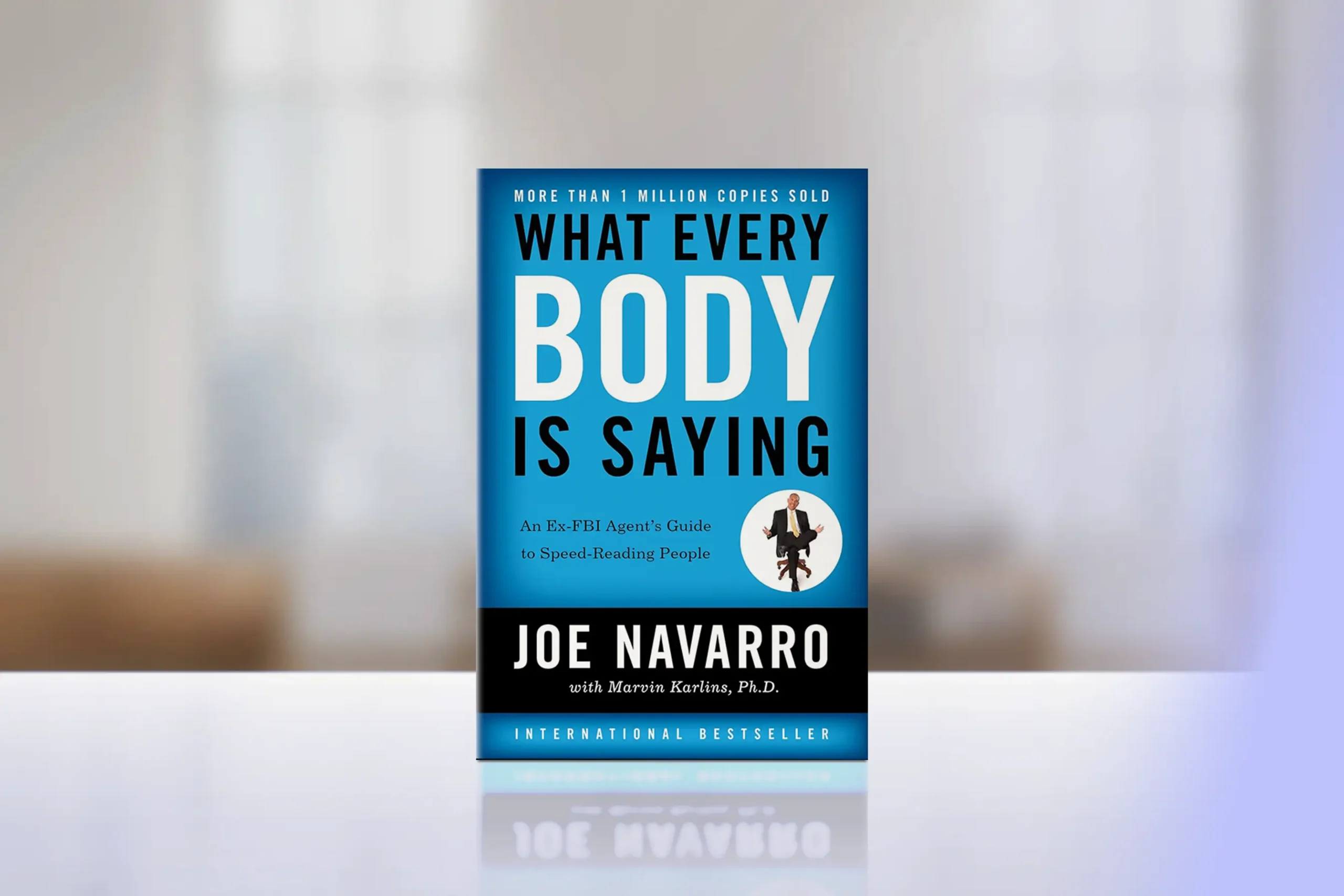Published in 2008, “What Every Body Is Saying” by Joe Navarro, takes readers on a fascinating journey into the world of nonverbal communication, drawing from the author’s 25-year career as an FBI counterintelligence agent.
At its heart, this book reveals how our bodies constantly broadcast information through unconscious behaviors – signals that, once understood, can dramatically enhance our ability to understand and connect with others.
Navarro’s unique blend of hands-on law enforcement experience and scientific research makes this more than just another body language guide; it’s a field-tested manual for reading the unspoken messages we all send.
Core Concepts
Navarro organizes his insights around several key principles that form the foundation of effective nonverbal communication analysis:
- The Limbic System’s Role in Nonverbal Behavior: Our brain’s limbic system operates independently of our conscious mind, producing involuntary behaviors that reveal our true feelings and intentions, making its signals more reliable than verbal communication.
- The Critical Role of Context in Reading Body Language: Nonverbal behaviors must always be interpreted within their specific context, considering factors such as culture, environment, and individual circumstances.
- Focus on Clusters of Behaviors Rather Than Single Gestures: Individual gestures can be misleading, but clusters of nonverbal behaviors occurring together provide more reliable indicators of someone’s true emotional state or intentions.
- The Importance of Establishing Behavioral Baselines: Before interpreting someone’s nonverbal cues, it’s essential to understand their normal behavior patterns to identify significant deviations.
- Reading Body Language from Head to Toe: A systematic approach to observing nonverbal cues ensures no significant signals are missed.
Chapter-by-Chapter Review
Mastering the Secrets of Nonverbal Communication
Navarro introduces the scientific foundation of nonverbal behavior and why our bodies often reveal more truth than our words. He emphasizes the evolutionary basis for our nonverbal behaviors and how they’ve developed as survival mechanisms. The chapter also explores how understanding these ancient patterns can give us insight into modern human behavior.
Living Our Limbic Legacy
This chapter explains how our primitive brain controls most nonverbal behaviors, making them more reliable indicators than conscious communication. Navarro delves into the fascinating world of freeze, flight, and fight responses, showing how these ancient survival mechanisms manifest in modern situations. He provides detailed examples of how the limbic system’s responses can be observed in everyday interactions, from business meetings to personal relationships.
The Torso, Hips, Legs, and Feet
Readers learn why the lower body often provides the most honest nonverbal signals and how to interpret them accurately. The chapter includes extensive discussion of comfort and discomfort displays, territorial behaviors, and how people unconsciously position themselves relative to others. Navarro shares specific examples from his FBI career to illustrate these concepts in high-stakes situations.
The Magic of the Face
This section covers facial expressions, including how to distinguish genuine from artificial displays of emotion. Navarro explains micro-expressions, eye behaviors, and the significance of various facial muscle movements. He provides practical exercises for improving facial expression recognition and understanding cultural differences in facial displays.
The Upper Body
Detailed analysis of arm movements, hand gestures, and upper body positioning and their meanings. The chapter explores how different cultures use hand gestures and the universal aspects of upper body language that transcend cultural boundaries. Navarro includes specific examples of how these signals manifest in business and personal settings.
Detecting Deception
The final chapters provide practical guidance for identifying potential deception through nonverbal cues. Navarro emphasizes the importance of looking for clusters of deceptive behaviors rather than single “tells” and provides real-world examples from his law enforcement experience. The section includes common myths about deception detection and how to avoid them.
Key Strengths
- Based on real-world law enforcement experience
- Scientifically grounded explanations
- Abundant photographs and examples
- Practical applications for everyday situations
- Clear methodology for observation and interpretation
Potential Drawbacks
- Some concepts require significant practice to master
- May create initial self-consciousness about body language
- Could be misused if applied without proper context
Who This Book Is For
This book is particularly valuable for:
- Business professionals who want to improve their people skills
- Leaders and managers seeking to better understand their teams
- Anyone interested in improving their interpersonal communication
- Professionals who work closely with others (teachers, counselors, sales)
Final Review
“What Every Body Is Saying” stands out as a practical, science-based guide to understanding nonverbal communication. Navarro’s law enforcement background adds credibility and real-world application to the theoretical concepts. While mastering these skills requires practice, the potential benefits in both professional and personal relationships make it well worth the effort. The book’s methodical approach to observing and interpreting body language provides readers with a reliable framework they can apply immediately in their daily interactions.
Rating: 4.6/5
An invaluable resource for anyone seeking to improve their ability to understand and connect with others through nonverbal communication.

Alternative Books
For readers interested in exploring similar themes, consider these highly-rated alternatives:

“Emotional Intelligence” by Daniel Goleman
Explores the broader context of understanding and responding to others’ emotions.
Rating: 4.5/5

“Crucial Conversations” by Kerry Patterson et al.
Provides complementary skills for handling high-stakes communications effectively.
Rating: 4.6/5

“How to Win Friends and Influence People” by Dale Carnegie
Offers additional insights into human behavior and effective communication.
Rating: 4.7/5





